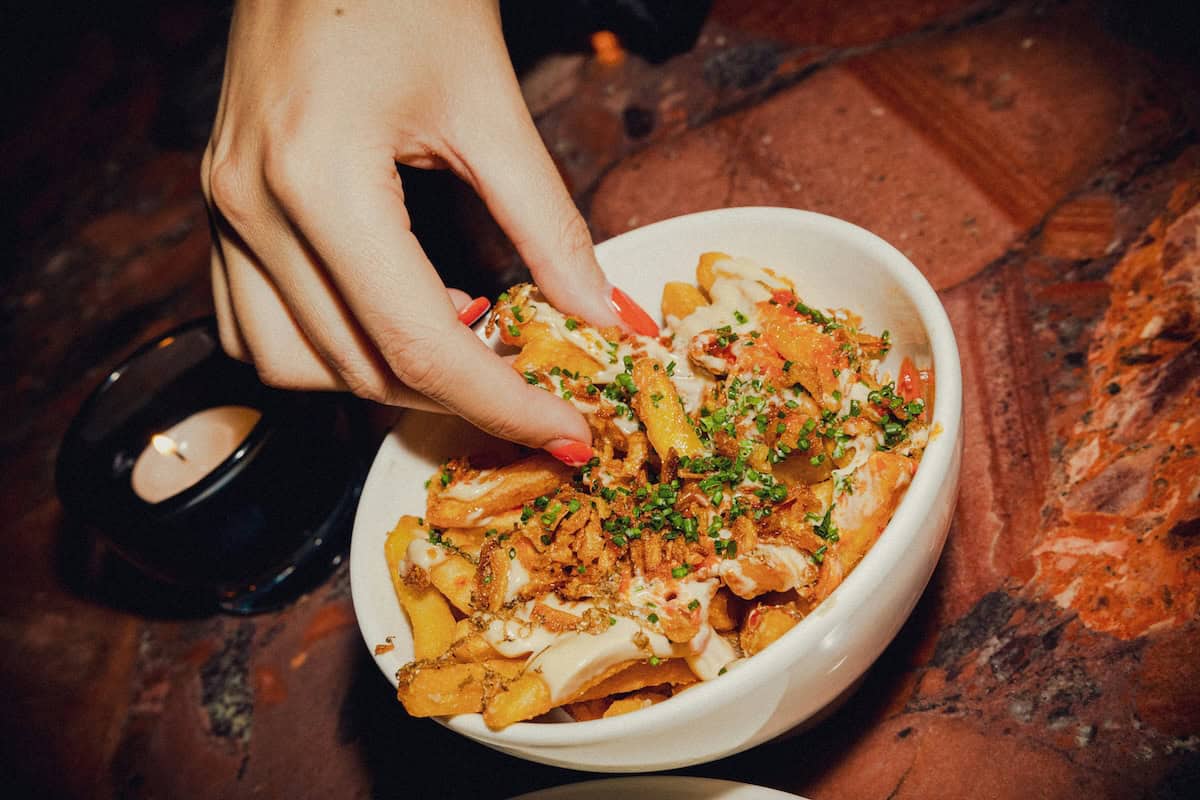
What if You’re an Adventurous Eater and Your Travel Buddy is a Picky Eater? Navigating Foodie Travel Preferences Without Drama
By: Heather Keys
Skip to Section
Article Summary
You want to sample that sketchy-looking street cart serving mystery meat on a stick, while your travel buddy’s already asking if Italy has chicken fingers. Sounds like a recipe for vacation disaster, right? Wrong! Foodie-picky eater pairs can absolutely rock a trip together.
This guide breaks down the four main food personalities you’ll encounter on the road, from culinary explorers who plan vacations around restaurant reservations to comfort food champions who’ve mastered the art of finding chicken tenders in any language. You’ll learn why opposite eating styles actually solve problems you didn’t know you had, plus get practical strategies for restaurant research, smart dining choices, and clear communication that prevents hangry street arguments. The article covers foodie-friendly destinations and handles the tricky stuff like dietary restrictions and emergency snack planning.
- Food halls and tapas restaurants let everyone choose their comfort level while eating together without compromise
- Smart restaurant research using Google Maps and Instagram photos prevents unpleasant surprises for both types
- Italy offers universal safety nets like pizza and pasta while satisfying foodies with regional specialties and truffle hunting
- Clear communication with code words and fair turn-taking rules keeps everyone fed and happy
- Emergency snacks and translation apps handle dietary restrictions and language barriers like a pro
Let’s talk about the elephant in the restaurant. You know, the one sitting between you and your travel buddy when you’re trying to pick where to eat in Rome. You want to try the hole-in-the-wall place serving traditional carbonara, and they want to know if Italy has chicken fingers.
It sounds like a match made in you-know-where, but we’ve got great news: foodie-picky eater pairs can vacation together! You just need the right game plan.
4 Types of Food Personalities
First, let’s get honest about who we’re dealing with here. These aren’t just “adventurous” versus “safe” eaters. Food personalities run way deeper than that.
The Culinary Explorer
Your meals are edible experiences. Your vacation planning starts with restaurant reservations over hotel bookings. You know what molecular gastronomy means, and you’re not afraid to use it in casual conversation.
You’ve got Eater bookmarked on every device, and your bucket list includes specific dishes in specific cities.
The Comfort Food Champion
You’ve found what works, and you’re sticking with it. Pizza is pizza, whether you’re in Naples or New Jersey. You possess an almost supernatural ability to find chicken tenders on any menu, in any language. You pack snacks not because you’re pessimistic, but because you’re smart.
The Texture Sensitive Soul
For you, it’s not about taste but mouthfeel. Mushrooms could taste like chocolate for all you know, but that spongy bounce is a hard pass. You’ve got very specific, very logical reasons for your food choices that make total sense to you: you can identify hidden onions through three layers of sauce, and you knew that smooth soup would have surprise chunks without dipping a spoon into it.
The Dietary Restriction Navigator
Medical necessity, ethical choice, religious requirement, or otherwise, you’ve got specific food needs. Maybe you’re managing celiac disease, living your best vegan life, or keeping kosher. Either way, dining out requires homework, and you’ve perfected the art of the polite but firm “No, seriously, not even a little bit of dairy” conversation with servers worldwide.
Why Food Opposites Make Great Teams
Opposite foodie pairings solve problems you didn’t even know you had. Let’s look at a few cases where it works!
The Reality Check Factor
Your picky eater saves you from overly gimmicky dining moments. While you’re ready to drop serious cash on “essence of tomato,” they remind you that food can be art, but it also should nourish you. Plus, they’re your backup plan when culinary adventures go sideways. Fermented shark may have seemed like a good idea, but you might find that your picky pal was onto something when they put trail mix in their bag.
The Gentle Push Principle
On the other end of the spectrum, your foodie knowledge can help selective eaters branch out safely. You know which “weird” foods taste familiar, and you can translate menu-speak into plain English. You’ll be able to order plates perfect for sharing, allowing tiny tastes without full commitment. And you teach your less adventurous buddy that sometimes basic done perfectly beats complicated done poorly.
Strategies for Traveling and Dining with Your Opposite Foodie Friends
Here are a few ways that you can travel well with a foodie friend with totally different tastes from yours.
Research Places to Eat
Technology is your friend here. Pull up Google Maps to quickly find menus for restaurants you’re considering. Your foodie scans for exciting dishes while your picky eater looks for safe bets and alternatives just in case.
Photos are better than descriptions, too. TripAdvisor user photos show real portions and presentations rather than the more professional marketing photos you might find on that restaurant’s website – go to Instagram to find diner photos too! Visual proof can go a long way toward preventing unpleasant surprises.
Build shared restaurant lists, too. Start with places with easy options for everyone, and build out from there. Planning prevents hangry street arguments that nobody wins.
Choose Smart Dining Options
Food halls and markets are relationship savers. Time Out Market locations in Lisbon, New York, and beyond let everyone choose their comfort level while eating together. No compromises, no conflicts.
Tapas and family-style restaurants also work brilliantly. Order lots to share. Picky eaters can fill up on safe bets while trying tiny bites of adventurous stuff. And don’t forget your hotel breakfast buffets! These extensive spreads might offer familiar and local options – everyone starts the day fed and happy, making lunch negotiations way easier.
Focus on Clear Communication Without Drama
Develop code words for food panic. “Interesting menu” might mean “I see nothing edible here.” “Should we check one more place?” could translate to “Please don’t make me eat here.”
Take turns picking restaurants, but with rules. Foodie picks must include safe options. Picky picks challenge foodies to find the best option available. Fair trades keep everyone happy.
And finally, set meal budgets that work for both of you – for example, you could balance splurge dinners with casual lunches. Nobody should feel guilty about preferences or forced into uncomfortable territory.
Destinations That Welcome Every Eating Style
Italy
Even the pickiest eaters usually find something Italian they love. Pizza, pasta, and gelato form a universal safety net. Meanwhile, foodies can obsess over regional specialties, truffle hunting, and wine pairings.
Rome offers everything imaginable: street food like supplì for quick bites, traditional trattorias for classics, and Michelin-starred restaurants for special occasions. Bologna brings serious food cred while keeping simple pasta available everywhere.
Japan
Don’t let sushi scare you off. Tokyo has more variety than anywhere, and there are plastic food displays everywhere to show you precisely what you’re getting, no surprises. Beyond raw fish, find amazing katsu (breaded cutlets), simple rice bowls, and even familiar fast food when needed. Osaka street food lets adventurous eaters go wild while cautious ones stick to safer options like yakitori.
Spain
Tapas culture naturally accommodates different preferences. Order several small plates so that you can avoid huge commitments to anything scary. Simple crowd-pleasers always available: tortilla española, jamón, cheese, patatas bravas. Foodies can chase the more wild bites while their partners stick to proven winners.
USA
American road trips offer incredible flexibility. Every town has chains alongside local standouts. New Orleans serves complex Creole alongside simple po’boys. Portland food trucks range from basic burgers to wild fusion. BBQ road trips through the South work for most. Meat, sides, done. Big cities like NYC have every cuisine within blocks. Someone wants authentic Thai while another needs pizza? No problem.
Handling Dietary Restrictions Properly
Allergies and dietary choices add complexity but stay totally manageable.
Translation Tech and Cards
Google Translate’s camera feature can read menus instantly. Download your host country’s languages before traveling, and you’ll be able to translate in real-time without needing an internet connection. And if you have medical restrictions, Equal Eats creates custom allergy cards in 50+ languages.
Learn key phrases, as well. Most servers appreciate effort and take requests seriously when you try their language. Practice pronunciation using language apps before you go, and it can really help with communication and patience while navigating meal questions and preferences.
Pick Cuisine-Friendly Destinations
Some cuisines naturally work better for different types of eaters. Indian food rocks for vegetarians, while Thai cuisine easily adapts to various needs. Mexican food uses corn tortillas, which are generally gluten-free.
Connect online before traveling. Facebook groups for travelers with dietary restrictions exist everywhere. They know which restaurants get it and which local dishes naturally fit your needs.
Pack Emergency Snacks
Always pack safe foods! Hunger makes everything more difficult. When your foodie wants that questionable street vendor, you won’t feel pressured if you’re not starving. Find grocery stores near your accommodation – knowing where to buy familiar foods will help reduce anxiety. Most international cities have health food stores with specialty items.
The Real Secret to Food Harmony
Stop trying to convert each other. Start appreciating what each brings to the table (literally). Your foodie friend opens doors to flavors and experiences. Your selective eater keeps you grounded and fed when experiments fail.
Now, who’s hungry?
About the Author
Originally from Indiana, Heather believes every destination has a story worth telling and a reason to visit. With a deep love of adventure, history, and psychology, she shares travel trivia, tips, and inspiration to encourage you to explore the world with curiosity and optimism. Read her other articles on Frayed Passport here.Featured image by Edward Howell on Unsplash
Information published on this website and across our networks can change over time. Stories and recommendations reflect the subjective opinions of our writers. You should consult multiple sources to ensure you have the most current, safe, and correct details for your own research and plans.
Frayed Passport is a participant in the Amazon Associates Program, an affiliate advertising program designed to provide a means for sites to earn advertising fees by advertising and linking to Amazon.com. We also may share links to other affiliates and sponsors in articles across our website.




